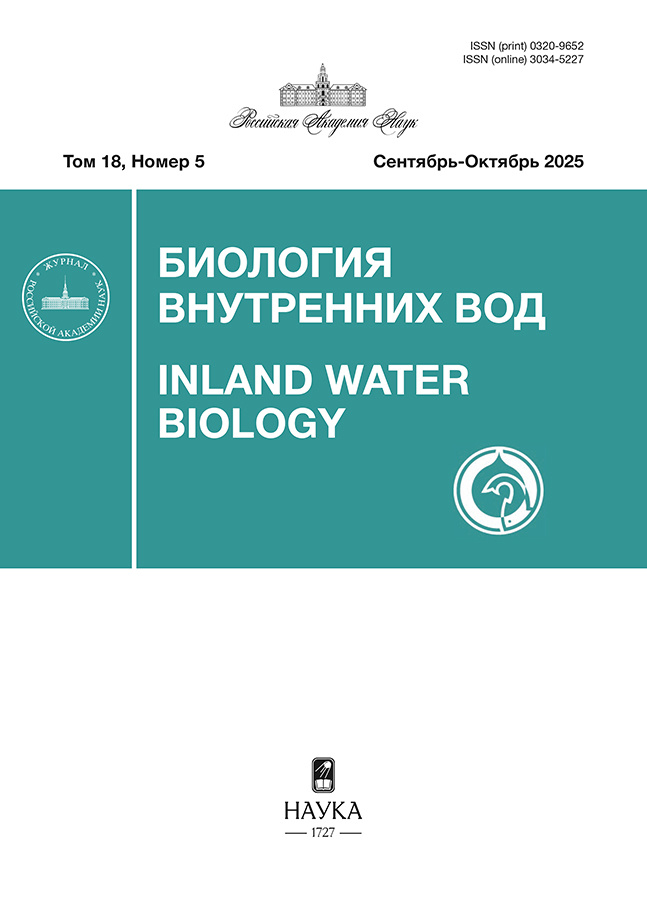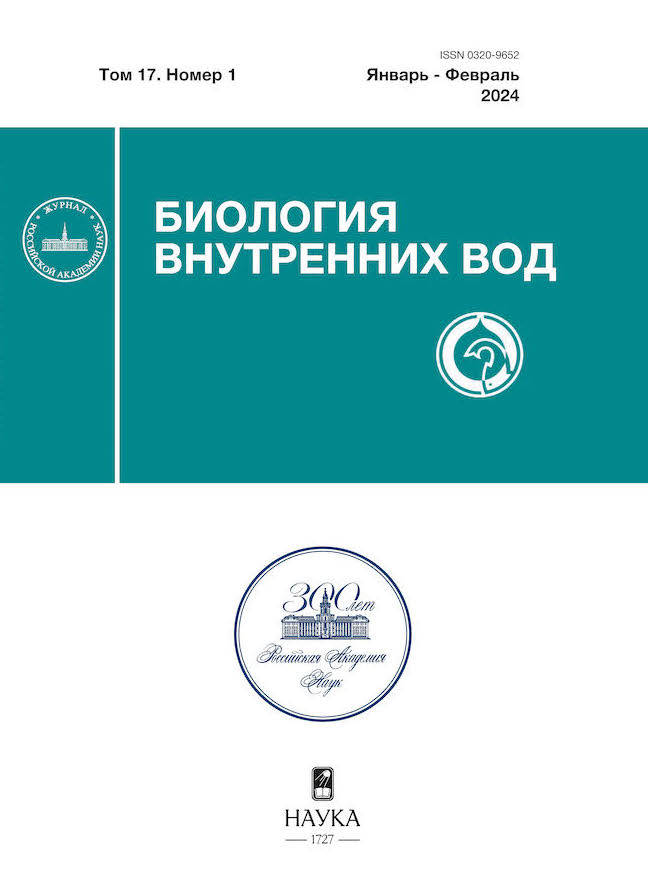Амбивалентность планктонных вселенцев и трансформация сообществ
- Авторы: Телеш И.В.1, Науменко Е.Н.2
-
Учреждения:
- Зоологический институт Российской академии наук
- Калининградский государственный технический университет
- Выпуск: Том 17, № 1 (2024)
- Страницы: 194-204
- Раздел: Статьи
- URL: https://rjeid.com/0320-9652/article/view/670188
- DOI: https://doi.org/10.31857/S0320965224010165
- EDN: https://elibrary.ru/yyyijl
- ID: 670188
Цитировать
Полный текст
Аннотация
Амбивалентность планктонных вселенцев изучена на примере экосистемных эффектов инвазийных ветвистоусых рачков Cercopagis pengoi (Ostroumov, 1891) в Вислинском заливе Балтийского моря. Исследовано влияние вселенца на таксономическую структуру и продуктивность планктона. Установлено, что в многолетнем аспекте пресс C. pengoi на зоопланктон сократился; численность, биомасса и продукция доминирующих видов Rotifera, Cladocera и Copepoda также снизились. Негативное воздействие C. pengoi на планктонное сообщество выразилось в сокращении кормовой базы молоди балтийской сельди и других рыб-планктофагов. Широкая экологическая ниша церкопагиса способствует расширению его ареала, что может привести к сокращению популяций рачков-фитофагов, усилению “цветений” воды и дальнейшему ухудшению кормовой базы рыб.
Ключевые слова
Полный текст
Об авторах
И. В. Телеш
Зоологический институт Российской академии наук
Автор, ответственный за переписку.
Email: Irena.Telesh@zin.ru
Россия, Санкт-Петербург
Е. Н. Науменко
Калининградский государственный технический университет
Email: Irena.Telesh@zin.ru
Россия, Калининград
Список литературы
- Александров С.В. 2010. Первичная продукция планктона в лагунах Балтийского моря (Вислинский и Куршский заливы). Калининград: Атлант НИРО.
- Алимов А.Ф., Богатов В.В., Голубков С.М. 2013. Продукционная гидробиология. СПб: Наука.
- Алимов А.Ф., Богуцкая Н.Г., Орлова М.И. и др. 2004. Антропогенное распространение видов животных и растений: процесс и результат // Биологические инвазии в водных и наземных экосистемах. М.; СПб.: Тов-во науч. изд. КМК. С. 16.
- Балушкина Е.В., Винберг Г.Г. 1979а. Зависимость между длиной и массой тела планктонных ракообразных // Экспериментальные и полевые исследования биологических основ продуктивности озер. Л.: ЗИН АН СССР. С. 58.
- Балушкина Е.В., Винберг Г.Г. 1979б. Зависимость между массой и длиной тела у планктонных животных // Общие основы изучения водных экосистем. Л.: Наука. С. 169.
- Дгебуадзе Ю.Ю., Петросян В.Г., Хляп Л.А. 2018. Самые опасные инвазионные виды России (ТОП-100). М.: Тов-во науч. изд. КМК.
- Дмитриева О.А. 2018. Встречаемость и многолетняя динамика вида-вселенца динофитовых водорослей Prorocentrum minimum в Вислинском заливе Балтийского моря в 2002–2010 годах // Тр. АтлантНИРО. Т. 2. № 1(5). Калининград: АтлантНИРО. С. 29.
- Иванова М.Б. 1985. Продукция планктонных ракообразных в пресных водах. Л.: Зоол. ин-т АН СССР.
- Киселев И.А. 1969. Планктон морей и континентальных водоёмов. Т. 1. Вводные и общие вопросы планктонологии. Л.: Наука.
- Науменко Е.Н. 2018. Сезонная и многолетняя динамика численности популяции вселенца Cercopagis pengoi (Ostroumov, 1891) в Вислинском (Калининградском) заливе Балтийского моря // Рос. журн. биол. инвазий. № 1. С. 29.
- Науменко Е.Н., Полунина Ю.Ю. 2000. Cercopagis pengoi (Ostroumov, 1891) (Crustacea, Cladocera) – новый вселенец в Вислинский залив Балтийского моря // Виды-вселенцы в европейских морях России. Сб. науч. тр. ММБИ КНЦ РАН, Апатиты. С. 121.
- Науменко Е.Н., Телеш И.В. 2019. Воздействие вселенца Cercopagis pengoi (Ostroumov, 1891) на структурно-функциональную организацию зоопланктона Вислинского залива Балтийского моря // Рос. журн. биол. инвазий. № 2. C. 64.
- Науменко Е.Н., Ушакова А.Ю. 2018. Спектры питания молоди рыб Вислинского залива Балтийского моря // Изв. Калининград. гос.-техн. ун-та. Т. 51. С. 13.
- Салазкин А.А., Иванова М.Б., Огородникова В.А. 1984. Методические рекомендации по сбору и обработке материалов при гидробиологических исследованиях на пресных водоемах. Зоопланктон и его продукция. Л.: ГосНИОРХ.
- Телеш И.В., Большагин П.В., Панов В.Е. 2001. Количественная оценка воздействия вида-вселенца Cercopagis pengoi (Crustacea: Onychopoda) на структуру и функционирование планктонного сообщества в Финском заливе Балтийского моря // Докл. акад. наук. Т. 377. № 3. С. 427. https://doi.org/10.1023/a:1019278212086
- Antsulevich A., Välipakka P. 2000. Cercopagis pengoi — new important food object of the Baltic herring in the Gulf of Finland // Int. Rev. Hydrobiol. V. 85. P. 609. https://doi.org/10.1002/1522-2632(200011) 85:5/6<609:AID-IROH609>3.0.CO;2 S
- Bagheri S., Niermann U., Mansor M., Yeok F.S. 2014. Biodiversity, distribution and abundance of zooplankton in the Iranian waters of the Caspian Sea off Anzali during 1996–2010 // J. Mar. Biol. Assoc. UK. V. 94. P. 129. https://doi.org/10.1017/S0025315413001288
- Bax N., Williamson A., Aguero M., Gonzalez E., Geeves W. 2003. Marine invasive alien species: a threat to global biodiversity // Mar. Policy. V. 27. № 4. P. 313. https://doi.org/10.1016/S0308-597X(03)00041-1
- Bielecka L., Krajewska-Sołtys A., Mudrak-Cegiołka S. 2014. Spatial distribution and population characteristics of the invasive cladoceran Cercopagis pengoi in the Polish coastal zone seven years after the first record // Oceanol. Hydrobiol. Stud. V. 43. P. 201. https://doi.org/10.2478/s13545-014-0134 y
- Borza P., Arbačiauskas K., Zettler M.L. 2021. Multidimensional niche differentiation might buffer invasion impacts: the case of oligohaline corophiids (Crustacea: Amphipoda) in the Baltic Sea // Biol. Invasions. V. 23. P. 1891. https://doi.org/10.1007/s10530-021-02479-7
- Chubarenko B.V. 2008. The Vistula Lagoon // Transboundary waters and basins in the South-East Baltic. Kaliningrad: Terra Baltica. P. 37.
- Chubarenko B.V., Zakirov R.B. 2021.Water Exchange of Nontidal Estuarine Coastal Vistula Lagoon with the Baltic Sea // J. Waterway Port Coast. Ocean Eng. V. 147. № 4. P. e05021005. https://doi.org/10.1061/(ASCE)WW.1943-5460.0000633
- Feit B., Dempster T., Jessop T.S., Webb J.K., Letnic M. 2020. A trophic cascade initiated by an invasive vertebrate alters the structure of native reptile communities // Global Change Biol. V. 26. № 5. P. 2829. https://doi.org/10.1111/gcb.15032
- Fussmann G., Heber G. 2002. Food web complexity and chaotic population // Ecol. Lett. V. 5. P. 394. https://doi.org/10.1046/j.1461-0248.2002.00329.x
- Golubkov M.S., Litvinchuk L.F., Golubkov S.M. 2020. Effects of environmental gradients on the biomass of alien Cercopagis pengoi in the Neva Estuary // Front. Mar. Sci. V. 7. P. e573289. https://doi.org/10.3389/fmars.2020.573289
- Gorokhova E., Fagerberg T., Hansson S. 2004. Predation by herring (Clupea harengus) and sprat (Sprattus sprattus) on Cercopagis pengoi in a western Baltic Sea bay // ICES J. Mar. Sci. V. 61. P. 959. https://doi.org/10.1016/j.icesjms.2004.06.016
- Helenius L.K., Leskinen E., Lehtonen H., Nurminen L. 2017. Spatial patterns of littoral zooplankton assemblages along a salinity gradient in a brackish sea: A functional diversity perspective // Estuar. Coast. Shelf Sci. V. 198. P. 400. https://dx.doi.org/10.1016/j.ecss.2016.08.031
- Hillebrand H., Langenheder S., Lebret K. et al. 2018. Decomposing multiple dimensions of stability in global change experiments // Ecol. Lett. V. 21. P. 21. https://doi.org/10.1111/ele.12867
- Karlson B., Andersen P., Arneborg L. et al. 2021. Harmful algal blooms and their effects in coastal seas of Northern Europe // Harmful Algae. V. 102. P. e101989. https://doi.org/10.1016/j.hal.2021.101989
- Kotta J., Simm M., Kotta I. et al. 2004. Factors controlling long-term changes of the eutrophicated ecosystem of Pärnu Bay, Gulf of Riga // Hydrobiologia. V. 514. P. 259. https://doi.org/10.1023/B:hydr.0000018224.56324.44
- Lankov A., Ojaveer H., Simm M. et al. 2010. Feeding ecology of pelagic fish species in the Gulf of Riga (Baltic Sea): The importance of changes in the zooplankton community // J. Fish Biol. V. 77. № 10. P. 2268. https://doi.org/10.1111/j.1095-8649.2010.02805.x
- Laxson C.L., McPhedran K.N., Makarewicz J.C. et al. 2003. Effects of the nonindigenous cladoceran Cercopagis pengoi on the lower food web of Lake Ontario // Freshwater Biol. V. 4. P. 2094. https://doi.org/10.1046/j.1365-2427.2003.01154.x
- Ojaveer H., Kotta J., Outinen O. et al. 2021. Meta-analysis on the ecological impacts of widely spread non-indigenous species in the Baltic Sea // Sci. Totаl Environ. V. 786. P. e147375. https://doi.org/10.1016/j.scitotenv.2021.147375
- Ojaveer H., Lumberg A. 1995. On the role of Cercopagis (Cercopagis) pengoi (Ostroumov) in Pärnu Bay and the NE part of the Gulf of Riga ecosystem // Proc. Estonian Acad. Sci., Ser. Ecol. V. 5. P. 20. https://www.researchgate.net/publication/29725481
- Ojaveer H., Simm M., Lankov A. 2004. Population dynamics and ecological impact of the non-indigenous Cercopagis pengoi in the Gulf of Riga (Baltic Sea) // Hydrobiologia. V. 522. P. 261. https://doi.org/10.1023/B:HYDR.0000029927.91756.41
- Perrings C. 2002. Biological invasions in aquatic systems: The economic problem // Bull. Mar. Sci. V. 70. № 2. P. 541. https://www.researchgate.net/publication/233675727
- Ricciardi A., Iacarella J.C., Aldridge D.C. et al. 2021. Four priority areas to advance invasion science in the face of rapid environmental change // Environ. ReV. V. 29. P. 119. https://doi.org/10.1139/er-2020-0088
- Rowe O.F., Guleikova L., Brugel S. et al. 2016. A potential barrier to the spread of the invasive cladoceran Cercopagis pengoi (Ostroumov, 1891) in the Northern Baltic Sea // Reg. Stud. Mar. Sci. V. 3. P. 8. https://doi.org/10.1016/j.rsma.2015.12.004
- Shackleton R.T., Biggs R., Richardson D.M., Larson B.M.H. 2018. Social-ecological drivers and impacts of invasion-related regime shifts: consequences for ecosystem services and human wellbeing // Environ. Sci. Policy. V. 89. P. 300. https://doi.org/10.1016/j.envsci.2018.08.005
- Szydłowski M., Kolerski T., Zima P. 2019. Impact of the artificial strait in the Vistula Spit on the hydrodynamics of the Vistula Lagoon (Baltic Sea) // Water. V. 11. № 5. P. e990. https://doi.org/10.3390/w11050990
- Telesh I.V., Khanaychenko A.N., Skarlato S.O. 2020. The interplay of two invaders: can blooms of the potentially toxic dinoflagellates Prorocentrum cordatum be downregulated by the neritic copepods Acartia tonsa? // Protistology. V. 14. P. 103. https://doi.org/10.21685/1680-0826-2020-14-3-1
- Telesh I.V., Naumenko E.N. 2021. The impact of nuisance planktonic invaders on pelagic communities: a review of the Baltic Sea case studies // Protistology. V. 15. № 4. P. 206. https://doi.org/10.21685/1680-0826-2021-15-4-2
- Telesh I.V., Schubert H., Skarlato S.O. 2016. Ecological niche partitioning of the invasive dinoflagellate Prorocentrum minimum and its native congeners in the Baltic Sea // Harmful Algae. V. 59. P. 100. https://doi.org/10.1016/j.hal.2016.09.006
- Telesh I., Schubert H., Skarlato S. 2021. Abiotic stability promotes dinoflagellate blooms in marine coastal ecosystems // Estuar. Coast. Shelf Sci. V. 251. P. e107239. https://doi.org/10.1016/j.ecss.2021.107239
- Vilizzi L., Copp G.H., Hill J.E. et al. 2021. A global-scale screening of non-native aquatic organisms to identify potentially invasive species under current and future climate conditions // Sci. Total Environ. V. 788. P. e147868. https://doi.org/10.1016/j.scitotenv.2021.147868
- Vuorinen I., Hänninen J., Rajasilta M. et al. 2015. Scenario simulations of future salinity and ecological consequences in the Baltic Sea and adjacent North Sea areas — implications for environmental monitoring // Ecol. Indic. V. 50. P. 196. https://doi.org/10.1016/j.ecolind.2014.10.019
Дополнительные файлы




















